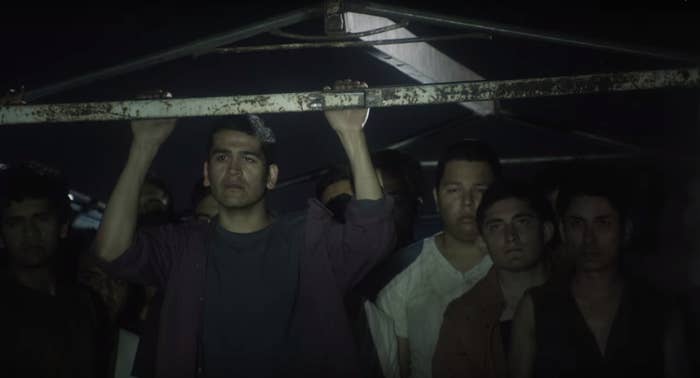
MEXICO CITY, Mexico — A film that purports to tell the story of 43 students who disappeared in Mexico wasn’t released when human rights groups first issued the call for its boycott.
“43 young men sent to their deaths. 2 cartels fighting to death. An uncomfortable truth,” says the movie’s trailer. The Night of Iguala is the latest in a duel between supporters of the different versions about what happened the night 43 students disappeared in Mexico, a case that has disgraced President Enrique Pena Nieto’s administration.
There is the official version — coined the “historical truth” by authorities and centered around a confrontation between rival gangs — and the version delivered by a panel of independent experts appointed by the Inter-American Commission for Human Rights which emphasizes that the students were unarmed and concludes that the government’s investigation is plagued with inconsistencies. The film is almost entirely loyal to the former.
“That campaign they are doing is supporting a truth that didn’t end up being true,” said Manuel Olivares Hernandez, director of the Regional Center for the Defense of Human Rights ‘Jose Maria Morelos y Pavon’, supporting relatives of the missing students. Olivares, who has urged Mexicans to avoid seeing the movie, says that the film will re-victimize and disgust relatives. A change.org petition released ahead of the movie demanding that any publicity related to it be removed has already garnered more than 2,000 signatures.
Some relatives of the missing teacher trainees say they do not want to see the film. It only adds insult to injury, said Erica Abrajan, wife of one of the missing men. “We know that what is in that movie is not true.”
On Monday evening, Alejandro Orozco bought one ticket and a bucket of popcorn before walking into the theater to watch the controversial film. The auditorium was empty except for three other people (the following screening also had less than a handful of theater-goers).
“I found out through the newspaper that this movie had come out,” said Orozco, a 35-year-old lawyer. “I’m interested in knowing if this is government propaganda so I can criticize it or if it’s critical so I can recommend it.”
The film is based on an investigation by journalist Jorge Fernandez Menendez, who also wrote the film and has openly supported the official version. “I think that it is an investigation that might have some errors, but it seems to me like an excellent investigation,” Fernandez Menendez said during a radio interview with Mexican journalist Ciro Gomez Leyva.
On September 26, 2014, students from Ayotzinapa rural teachers’ college went to Iguala, a city in the southwestern state of Guerrero, to commandeer several buses. Those buses were to be used to travel to Mexico City and participate in a march commemorating a student massacre that took place in 1968. Local police ambushed the students and piled 43 of them into a number of vehicles.
According to the government’s version, police confused the students for members of a criminal group and handed them over to Guerreros Unidos, a rival drug gang headed by Iguala’s mayor’s wife, Maria de los Angeles Pineda. (Iguala’s mayor just happens to be affiliated with a party opposed to Pina Nieto’s.). The students were taken to a trash dump, incinerated in a pyre that burned through the night, and then their ashes were dumped in a nearby river.
The international expert group disagrees. They released a report last month which concluded that the students could not have been burned in the trash dump identified by authorities and asserted that federal police knew that the teacher trainees were being attacked but did not intervene.
In the film, several re-enactments portray the students as rowdy party-goers and bandits who taunt police. Local police, in turn, appear to be trigger-happy, grinning almost comically as they push and kick the students. Tattooed gang members wearing wifebeaters resemble those of B-rated straight-to-cable movies. Federal forces are mentioned only once, in passing.

For an event which remains shrouded in mystery and plagued by fundamental questions, the film is surprisingly devoid of nuance. It boils down the night’s events to a conflict between rival drug gangs fighting over the region’s growing heroin business, exacerbated by the whims of Iguala’s mayor and his wife.
The documentary format is similar to a video produced by the attorney general’s office which recreated the night’s events: both are narrated by a male voice and maps of the region with red arrows showing the students’ route are interspersed among poorly-produced reenactments and confessions by detained suspects.
The students’ disappearance traumatized a country accustomed to tremendous violence since 2006, when former president Felipe Calderon launched an offensive against organized crime. Thousands of people marched down main thoroughfares in dozens of cities for weeks, demanding the return of the 43 students. As frustration grew, Pena Nieto’s image as the harbinger of a healthy economy and a series of constitutional reforms meant to modernize Mexico crumbled.
In January, then-Attorney General Jesus Murillo Karam gave a press conference in which he concluded that all the students had been incinerated by members of a local drug gang. He called it the historical truth before waving off reporters’ questions, saying he was tired.
Relatives of the missing students have criticised the official investigation as hasty and the authorities’ treatment of them as brusque. Instead, they have deposited their trust in the panel of experts.
When the 80-minute film ended, Orozco walked out of the theater and down a set of stairs in the worn-down building, shaking his head in disappointment.
He thought it would “throw out intelligent questioning.” Instead, Orozco said, “it validated Murillo Karam’s thesis.”
